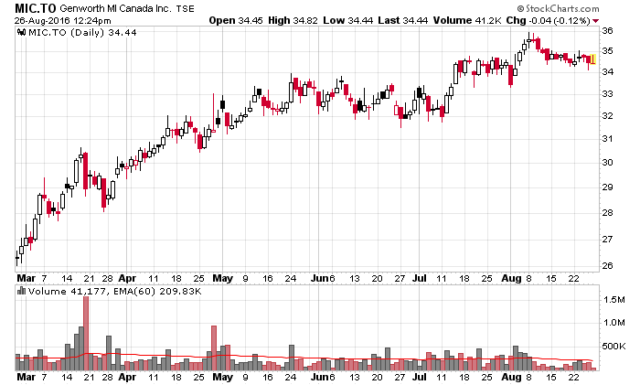Genworth MI (TSX: MIC) has gone nowhere in the past three months, despite the corporation lowering losses from insurance claims and the housing market being relatively stable to date. The company trades at a 10% discount to book value, and also at a P/E of 9 (realizing that these two metrics are not the only ones that insurance companies should be valued by, but suffice to say, unless if the insurance written is completely bad, it is difficult to lose money when buying something under book and under a P/E of 10).
There are a few cautionary flags – the reduction of their portfolio insurance business (which allows third-party financing firms to securitize and sell their lower loan-to-value mortgages with portfolio insurance) and also the slowdown in housing sale volumes, combined with the attempts by the BC Government to quell foreign ownership with a 15% transfer tax for non-permanent residents or citizens.
In particular, the transfer tax has caused quite a quenching of the roaring housing fire that was occurring in the southwestern BC housing market. This in turn has spooked the various markets linked to residential real estate. However, it is my assessment that as it relates to mortgage insurance, the market has continually over-estimated the impact of the short-term gyrations in Canadian real estate.
What would cause issues is mortgage serviceability and this is a function of employment, not housing prices. Although there is correlation between housing prices and construction-related employment, if there is not mass unemployment it is difficult to see how somewhat lower housing prices would cause difficulties in the mortgage insurance space. Indeed, the $300 billion ceiling for private insurance in Canada seems to be more of a daunting barrier than the state of the actual insurance market.
It is worthy to note that during the depths of the 2008-2009 financial crisis that the loss ratio peaked out at 46% (June 30, 2009) and this still resulted in a profitable book for the firm. The subsequent combined ratio peaked at 62%, which means that for every dollar of revenue booked that the firm recorded a gross profit of 38 cents.
Also, the corporate has increased its quarterly dividend every year for the past 5 years – it is currently 42 cents and if prior patterns continue they will likely raise it to 45 cents per share. Although the yield is not important (cash generation is), there are various market participants out there that only care about yield and this would serve to boost the stock price.
